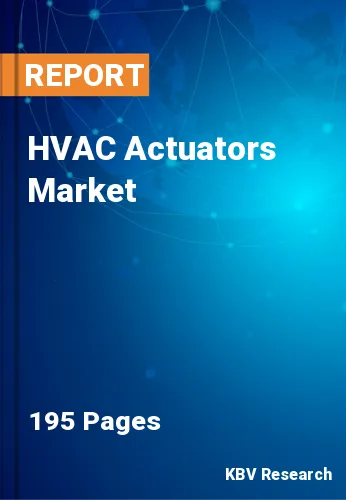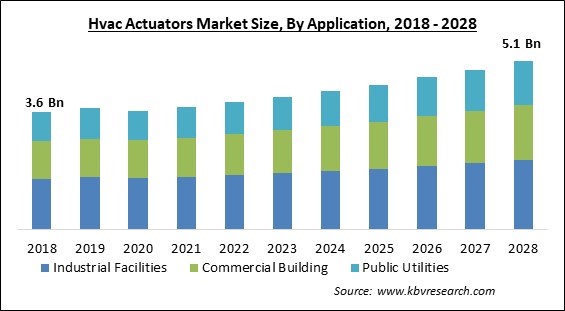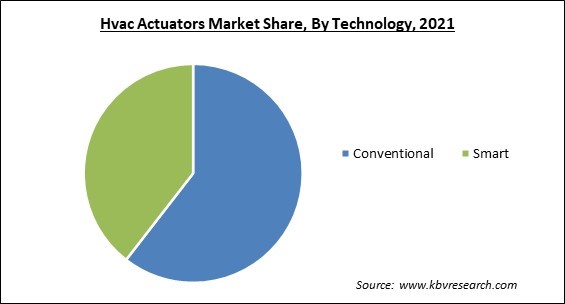
The Global HVAC Actuators Market size is expected to reach $5.1 billion by 2028, rising at a market growth of 4.7% CAGR during the forecast period.
A HVAC actuator uses a low-voltage signal to move the damper from fully open to totally close. An actuator is a device component capable of moving and manipulating specific elements of a system or mechanism. This is accomplished by giving the actuator a control signal, which the actuator subsequently transforms into mechanical motion, frequently a rotational motion, and operates upon its surroundings.

This control system can be as basic as a fixed mechanical input, a manual one, or as sophisticated and highly precise as a piece of software. More particularly, the damper is controlled by an HVAC actuator. The smoke and clean air flow within an HVAC system can be modified using these powered devices. These devices use a low-voltage signal to operate HVAC dampers. Since they act as a link between the control system and the mechanical system, which is essential for precise control, actuators have a wide range of applications.
Normally, the actuator receives 80% or more of the electronic signals sent to HVAC systems. They are maybe the most important part of the whole system because when they are placed improperly, the entire air system suffers. Zone dampers are an essential part of a heating, ventilation, and air conditioning (HVAC) system, and the dampers won't work without the right actuators.
The four most typical types of actuators used in HVAC are spring return on/off actuator, air volume modulating actuator, chilled water on/off actuator, and PIBCV modulating actuator. For instance, actuators must close fire dampers quickly and under extreme heat to preserve lives during a fire. Actuators are also in charge of controlling chilled water flow, which affects how energy-efficient an air conditioner is.
HVAC actuator demand declined due to low demand from various regions brought on by the government-imposed COVID-19 protocols in numerous nations. In addition, manufacturing of HVAC actuators for end users was suspended due to the COVID-19 pandemic, mostly due to protracted lockdowns in important international countries. The pandemic slowed the advancement of numerous commercial construction projects globally, reducing demand for HVAC systems. This affected the HVAC actuators market adversely. Additionally, due to strict lockdown measures, commercial buildings with air conditioning systems, including offices, malls, industrial buildings, and others, were closed.
Commercial buildings raise the demand for ventilation for improved air quality. The HVAC systems aid in maintaining high temperatures and the amount of dust in poor conditions. HVAC systems also reduce operating expenses. It is anticipated that rising government regulation and demand for effective HAV installation in commercial spaces will accelerate the demand for HVAC actuators. Additionally, the increasing industrialization and urbanization are propelling the construction of commercial spaces as well. In the upcoming years, this is anticipated to aid in the expansion of the HVAC actuators market.
HVAC systems are built to last and operate effectively. The HVAC actuators control their functions precisely and quickly. Because of the product's high durability and low energy usage, their demand is expected to rise. The equipment's adaptability and stability make it useful for volume control as well. Additionally, the rising demand for fail-proof equipment controls has facilitated numerous technological advancements. The rise of technologies like big data analytics and cloud computing has made the establishment of data centers worldwide necessary. All of these factors are anticipated during the forecast period to propel the HVAC actuators market.

The product life cycle of these systems has shrunk as a result of quick technological advancements. This is adversely impacting the profitability of suppliers of HVAC systems. Additionally, a significant lack of skilled professionals poses a major challenge to market growth. These barriers to HVAC system adoption are anticipated to have a direct impact on the expansion of the HVAC actuators market throughout the forecast period. During the forecast period, a lack of skilled professionals is anticipated to impact market growth.
Based on type, the HVAC actuators market is categorized into spring return and non-spring return. The spring return segment garnered the highest revenue share in the HVAC actuators market in 2021. In spring return actuators, the piston is supplied with liquid or air on one side, while a spring on the other side provides the force necessary to move the valve. A spring produces the opposite motion, opening or closing the valve depending on the pressure of the liquid or air. When the torque load is encountered on only one side during the activation stroke, this type of actuator is the right alternative.
On the basis of technology, the HVAC actuators market is divided into smart and conventional. The smart segment recorded a significant revenue share in the HVAC actuators market in 2021. Smart actuators are connected machines that can respond to external inputs with actuation and dampening capabilities. They are made of intelligent and synthetic materials (like light, heat, humidity, magnetism, electricity, and chemical reactions). With the aid of a tablet, smartphone, or desktop, users of a smart HVAC system can remotely control their HVAC equipment. A smart HVAC system offers customers more accessible, user-friendly, and efficient control.
Based on application, the HVAC actuators market is segmented into commercial building, industrial facilities, and public utilities. The industrial facilities segment witnessed the maximum revenue share in the HVAC actuators market in 2021. Larger facilities, including chemical processing, manufacturing, electricity production, and water treatment plants, benefit from the heating, cooling, and ventilation provided by industrial HVAC systems. This is responsible for the growth of the segment. Although they operate on the same fundamental principles as residential HVAC systems, they are more complicated and have a higher capacity.
| Report Attribute | Details |
|---|---|
| Market size value in 2021 | USD 3.7 Billion |
| Market size forecast in 2028 | USD 5.1 Billion |
| Base Year | 2021 |
| Historical Period | 2018 to 2020 |
| Forecast Period | 2022 to 2028 |
| Revenue Growth Rate | CAGR of 4.7% from 2022 to 2028 |
| Number of Pages | 195 |
| Number of Table | 330 |
| Report coverage | Market Trends, Revenue Estimation and Forecast, Segmentation Analysis, Regional and Country Breakdown, Companies Strategic Developments, Company Profiling |
| Segments covered | Technology, Type, Application, Region |
| Country scope | US, Canada, Mexico, Germany, UK, France, Russia, Spain, Italy, China, Japan, India, South Korea, Singapore, Malaysia, Brazil, Argentina, UAE, Saudi Arabia, South Africa, Nigeria |
| Growth Drivers |
|
| Restraints |
|
On the basis of region, the HVAC actuators market is analyzed across North America, Europe, Asia Pacific, and LAMEA. The Asia Pacific segment procured the highest revenue share in the HVAC actuators market in 2021. The growth of the region is owed to ongoing technological development. The market is expected to develop as a result of government policies and mandates for energy efficiency. It is projected that the region's rising urbanization and industrialization will accelerate market expansion. Additionally, the increasing demand for the internet of things (loT) in the HAVC sector will hasten market expansion.
Free Valuable Insights: Global HVAC Actuators Market size to reach USD 5.1 Billion by 2028
The market research report covers the analysis of key stake holders of the market. Key companies profiled in the report include Continental AG, Denso Corporation, Dwyer Instruments LTD.(Arcline Investment Management), Honeywell International, Inc., Johnson Controls International PLC, Robert Bosch GmbH, Schneider Electric SE , Siemens AG, ElectroCraft, Inc. (DMI Technology Corporation), and Rotork Plc.
By Type
By Technology
By Application
By Geography
The global HVAC Actuators Market size is expected to reach $5.1 billion by 2028.
Benefits of HVAC systems and actuators in numerous sectors are driving the market in coming years, however, Lack of knowledge and financial ambiguity restraints the growth of the market.
Continental AG, Denso Corporation, Dwyer Instruments LTD.(Arcline Investment Management), Honeywell International, Inc., Johnson Controls International PLC, Robert Bosch GmbH, Schneider Electric SE , Siemens AG, ElectroCraft, Inc. (DMI Technology Corporation), and Rotork Plc.
The Conventional segment acquired maximum revenue share in the Global HVAC Actuators Market by Technology in 2021 thereby, achieving a market value of $2.9 billion by 2028.
The Asia Pacific market dominated the Global HVAC Actuators Market by Region in 2021, and would continue to be a dominant market till 2028; thereby, achieving a market value of $2 billion by 2028.
Our team of dedicated experts can provide you with attractive expansion opportunities for your business.
